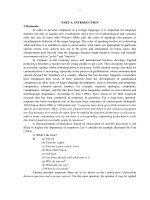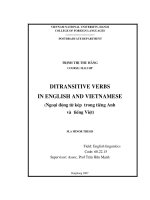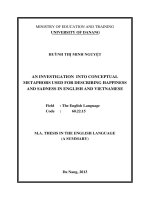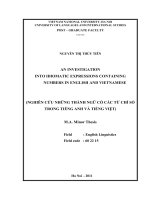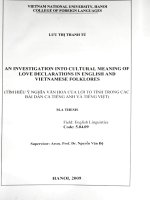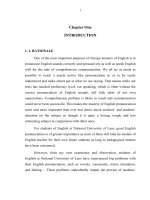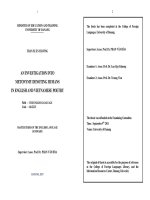An investigation into speech act verbs in english and vietnamese TV news transcripts
Bạn đang xem bản rút gọn của tài liệu. Xem và tải ngay bản đầy đủ của tài liệu tại đây (129.41 KB, 14 trang )
1
2
The thesis has been completed at the College of Foreign Languages,
MINISTRY OF EDUCATION AND TRAINING
UNIVERSITY OF DANANG
**************
DANANG UNIVERSITY
Supervisor: Assoc. Prof. Dr. Lưu Qúy Khương
TRẦN THỊ MỸ TÍN
Examiner 1: Assoc. Prof. Dr. Trương Viên
Examiner 2: Ngũ Thiện Hùng, Ph.D
AN INVESTIGATION INTO SPEECH ACT VERBS
IN ENGLISH AND VIETNAMESE TV NEWS
TRANSCRIPTS
Field Study : THE ENGLISH LANGUAGE
Code
: 60.22.15.
The thesis to be orally defended at the Examining Committee.
Time
: 23 /10/2010
Venue : University of Danang
M.A. THESIS
(A SUMMARY)
Supervisor: Assoc. Prof. Dr. LƯU QUÝ KHƯƠNG
The original of this thesis is accessible for purpose of reference at the
College of Foreign Languages Library, University of Danang and the
DANANG, 2010
Information Resources Center, University of Danang.
3
4
They considerably contribute to the communicative effects among
CHAPTER 1
participants.
INTRODUCTION
Nowadays, mass media are an indispensable part in spiritual life
1.1 Statement of the Problem
of people. Television is a powerful medium in which TV news is not
Language is considered to be a product of social contacts.
only one of the biggest sources of information but the one that has a
Modern linguistics has been referred to as the study of language
very profound influence on people’s lives. In TV news, we almost
as a system of human communication. Language can be used to
see all main social problems or in other words, it reflects our life. So,
describe the reality and to change it. Language can be used not
TV news is one of places where human beings’communication is
only to talk but also to do things. In simple words, it can be
described. In fact, TV news contains descriptions of reality of
asserted ‘to speak is to act’. Acts performed by language are
problems through reported speeches or quotations which are
called speech acts and the verbs used are known as speech act
composed of many speech act verbs.
verbs. Speech acts play an important role in effective
SAVs bring out definite effects on audience when applied to
communication. Speech act verbs are special phenomena on
speeches for problems or affairs in TV news. These SAVs play a key
which linguists have been doing researches. Actually, Austin
role in communicative effects of TV news. To give comments on or
(1962) discovered the fact that some statements can talk about
solutions to the problems, celebrities or ordinary people or reporters
something or refer to ‘true-false’ assertion like the following
use a lot of SAVs. In some cases, TV audiences wait for attitudes or
examples:
solutions towards hot problems made by related persons. For
(1) I run this meeting.
[258]
(2) You’re happy.
[258]
and other statements can refer to certain actions as follows:
(3) I thank you for your kind attention.
[258]
(4) I claim this land in the name of the King of England. [258]
(5) Mike promised to call once a week.
[254, p.15]
[258] example, in a piece of news on November 8th in 2009, TV viewers
[258] were informed of the serious floods in Elsalvador through the SAV
declare “Authorities have declared a state of emergency in five
[258] regions.” This SAV itself made the problem more serious, or in
another piece of news on June 13 with the headline “Bộ trưởng
[254, p.15]
Nguyễn
Thị Kim Ngân trả lời chất vấn” with the SAVs hỏi, cho biết
When the speaker utters statements (3), (4), he (she) performs the
in “nhiều ñại biểu ñã hỏi về nội dung lao ñộng, tình hình mất việc
actions of ‘thanking’ and ‘claiming’ through the speech act verbs
làm và giải quyết việc làm. Bộ trưởng cho biết ñang phối hợp với các
thank and claim rather than asserts the true-false facts. Speech act
bộ ngành Việt Nam giải quyết theo ñúng quy ñịnh của Pháp luật.”
verb promise in (5) is used to describe the action of ‘promising’ of
the speaker. In communication, speech act verbs are commonly used.
5
Thus, it is obvious that SAVs in TV news transcripts have not
been actually the focus of the research interest in their linguistic
features- semantics, syntax and pragmatics.
Furthermore, the research also contributes to helping language
learners grasp the usage of SAVs in TV news, one of factors which
decide the effects of pieces of news but they have not been much
6
fulfillment of learning and using languages in both English and
Vietnamese for everyone and students of journalisms.
1.2.2 Objectives
To achieve the aims above, the investigation will focus on
objectives as follows:
a.To find out the semantic, syntactic and pragmatic features
paid attention to. In addition, viewers may approach a variety of
of SAVs in representatives and expressives in TV news transcripts in
SAVs which help them to choose the right verbs to enhance
English and Vietnamese.
communicative effects in daily life especially in formal occasions. It
b. To find out the similarities and differences between SAVs
is also a helpful source of verbs for foreigners to improve their study
in the two classes: representatives and expressives in TV news
of foreign languages. Vietnamese teachers who teach English and
transcripts in English and Vietnamese.
English teachers who do researches on the Vietnamese language have
an opportunity to explore various SAVs to explain to their students.
Lastly, for broadcast jounalism students, the research is also the
reference for their study.They may have some knowledge about how
to use SAVs in TV news, one of the decisive factors creating the
influence of TV news on viewers.
c. To suggest some implications for language teaching and
learning in both English and Vietnamese as well as language use of
journalism students.
1.3 Scope of the Study
SAVs are commonly used in communication in every field of life
but we only do a research on SAVs in TV news transcripts in English
All the reasons mentioned above encourage us to do the research
and Vietnamese (electronic news). SAVs for the research are
on the topic “An Investigation into Linguistic Features of SAVs in
restricted to two categories: representatives and expressives and data
English and Vietnamese TV News Transcripts”.
collected are on TV channels of Vietnamese Television and BBC.
1.2 Aims and Objectives
1.4 Research Questions
1.2.1 Aims
The study is carried out with the aim to investigate semantic,
The thesis focuses on solutions to the research questions as
follows:
syntactic and pragmatic features of SAVs in English and Vietnamese
1. What are typical linguistic features (syntax, semantics and
TV news transcripts so as to help readers understand and take grasp
pragmatics)of SAVs in English and Vietnamese TV news transcripts?
of distinctive characteristics of this kind of verbs in English and
2. What are the similarities and differences of SAVs between
Vietnamese TV news. Besides, the research also contributes to the
English and Vietnamese TV news transcripts ?
3. What are factors that govern the choice of SAVs ?
7
1.5 Significance of the Study
8
Hewitt [13], Randall, James and Joseph [21], Mencher [18],
1.6 Organization of the Research
Clayton [6] emphasized broadcast news writers should be simplifiers.
This research has five chapters:
According to them, broadcast news writers should simplify complex
Chapter 1: Introduction
events and write in direct, daily language with short words in short
Chapter 2: Literature Review
sentences using present tense.
Chapter 3: Methods and Procedures
In Vietnamese, Trần Đức Tài, Lê Thanh Nhàn, Từ Lê Tâm,
Chapter 4: Findings and Discussion
Phạm Duy Phúc and Triệu Thanh Lê [40] referred to all aspects of
Chapter 5: Conclusion
journalism and journalism profession. They reflected all techniques
CHAPTER 2
LITERATURE REVIEW
2.1 A Review of Prior Studies Related to the Research
Hassanpour [257] mentioned distinctive features of language on
and skills in producing broadcasting news as well as concepts or
notions for journalists in particular and readers in general. “Nghề báo
nói” by Nguyễn Đình Lương [37] provided a lot of information of
TV genre. “Cơ sở lý luận báo chí truyền thông” by Dương Xuân
TV apart from language in other contexts. So he urged us to choose
Sơn, Đinh Văn Hường, Trần Quang Long also gave the overview of
TV language carefully so as to involve people. What he mentioned
broadcast news, and so on.
deals with various techniques of using TV language not about SAVs
in particular.
Harris [255] referred to the understanding of TV language which
is related to psychological features.
In terms of speech acts, Austin [1] is the first author to introduce
the idea of speech acts, analyzing the relationships between
utterances and performance, he mentioned the concept of
performative language. Austin created a clear distinction between
Also, Robertson [251] made a survey on the same topic with the
peformatives and constatives. Searle [24] posited five illocutionary
three channels: The Big Breakfast, Newsround and the BBC and the
points: assertives /representatives, expressives,directives,declaratives,
author concluded that “ they differ from each other in how they
and commissives.
present the news in terms of overall content and linguistic form, in
order to appeal in different ways to their audiences.” [251, p.35)
Thompson [27] gave examples of usages which should be
avoided when we write broadcast news. Besides, he and Block [3]
showed the principles of writing for scripts, “natural, conversational,
clear and concise”.
Levinson [17] proposed a ‘context-change theory’ of speech acts.
He felt that speech act theorists have failed to appreciate the
absolutely critical contribution of the context of the situation in
which the interaction takes place.
In respect of speech act verbs, Lenz [265] broadened the notion
of SAVs apart from the customary one as performative verbs in
speech act theory.
9
10
Wierzbicka [29] set a dictionary of English speech act verbs.
by print, broadcast, Internet, or word of mouth to a third party or
She assumed that the semantic primitive say is common to all
mass audience.”
speech act verbs. She also listed verbs like talk, chat or discuss in her
dictionary.
In another definition by Clayton [6, p.34], news is exactly “what
is says it is. Think about it. It is not ‘olds’, it is ‘news’. News stories
Puschmann [254] reviewed speech acts in Austin’s theory and
are never about history. It is vital you discover something new-
according to him, there are two types of speech act verbs, speech act
verbs functioning as describing communicative actions of others and
performative verbs.
something that has not happened before. ”
Đinh Văn Hường [35] collected a series of definitions of news
“News is something today different from yesterday, tomorrow is
In Vietnamese, Nguyễn Đức Dân [33] mentioned speech acts in
different from today about anything and anywhere in daily life” or
Austin’s theory and he focused on illocutionary act- its type in
“News is a piece of information around a remarkable event, has a
Austin’s words and Searle’s ones. From this, he analysed
general attraction”, “News is what is reflected again” or a bit
performative
unusual “News is something a person wants to keep as a secret but
utterances
and
performative
verbs
mainly
in
Vietnamese and in a few comparisions with English.
other wants to reveal”.
In Đỗ Hữu Châu’s analysis [32], performative verbs are included
In conclusion, we can understand that news is information about
in speech act verbs. Particularly, in Vietnamese, there are three types
“current events which is presented by print, broadcast, Internet, or
of speech act verbs.
word of mouth to mass audience”.
Cao Xuân Hạo [34] studied the functions of performative verbs
inVietnamese sentences and mentioned a list of performative verbs.
b. Notions of TV News
According to Wikipedia: “Television news refers to
He also presented the classification of Vietnamese sentences based
disseminating current events via the medium of television. “News
on the speech act theory.
bulletins” or “ newscasts” are programs lasting from seconds to
Trần Ngọc Mỹ Chi [5] investigated performative verbs in five
hours that provide updates on world, national, regional or local news
classes of speech acts.
events. Television news is very image-based, showing video of many
2.2 Theoretical Background
of the events that are reported.”
2.2.1 General View of TV News
2.2.1.1 Notions of TV News
a. Notions of News
News is defined by Wikipedia as follows: “News is the
communication of information on current events which is presented
In addition to the definition of TV news by Wikipedia,
Cremer, Keirsted and Yoakam [8] indicated that TV news is more
than just pictorical coverage. It “tells” the news with pictures in
motion including news sounds, and with words spoken by anchor
person, reporters, and news makers.
11
12
2.2.1.2 Structure of TV News
3.1 Research Methods
2.2.1.3 Functions of TV News
3.2 Sampling
a. Informative Function
3.3 Data Collection and Analysis
b. Management or Social Function
3.3.1 Data Collection
c. Educational Function
3.3.2 Data Analysis
d. Entertainment Function
2.2.1.4 Characteristics of TV News
3.4 Research Procedures
3.5 Reliability and Validity
2.2.1.5 Types of TV News
CHAPTER 4
FINDINGS AND DISCUSSION
2.2.2 Speech Acts
2.2.2.1 Speech Acts
4.1 Linguistic Features of English Speech Act Verbs
2.2.2.2 Austin’s Speech Act Theory
2.2.2.3 Searle’s Speech Act Theory
2.2.3 Speech Act Verbs
4.1.1 Syntactic Features of ESAVs
4.1.1.1 Representatives
a. English Performative Verbs
2.2.3.1 Performative Verbs
a1. Introduce and announce are in the pattern: S +V +O
a. The Form of Performatives
or disagree in: S+V + Prep + Prep O
b. The Nature, Function and Condition of the Use of
(4.1) We introduce a basic model for zombie infection.
[119]
(4.2) We may disagree about gay marriage.
[108]
Performatives
b1.The Nature
a2. Disagree is also in the pattern : S +V + PP
b2. Function of Performatives
b3. Condition of Performatives
2.2.3.2 Reporting Verbs
(4.4) I disagree strongly with us.
[86]
a3. Most EPVs are in the following pattern:
S +V +(that)+ clause or S +V +(conj)+ clause
( 4.5) We predict they will be applied to improve the beef industry.
a. Definition
[69]
b. Characteristics of RVs
c. The Form of RVs
d. Functions of RVs
a4. Remind and tell are in the structure: S +V + O+(that)
+clause or say is in the pattern: S +V +PP +that clause
(4.10) I must tell you that your decision is extremely regrettable and
2.3 Summary
CHAPTER 3
METHODS AND PROCEDURES
very difficult to accept.
a5. Agree is used in the pattern:
[92]
13
14
S +V +(that) + clause +conj+ clause
b7. Insist appears in the pattern:
(4.12) We can agree that it is unconscionable to target gays and
lesbians for who they are, whether it is here in the United States.
[108]
b. English Reporting Verbs
b1. Dismiss, say, announce, propose, acknowledge,
S +V +(that) +clause +conj +clause
(4.28) Google insisted it was nevertheless serving the public interest
even though it was furnishing censored results.
b8. Admit, and talk are present in the patterns:
[65]
S+V +NP/PP +PP
approve, recommend, claim, reject, compare, defend, offer,
( 4.29) Owen, who won Celebrity Big Brother in 2002, admitted the
question, introduce, reveal, repeat, describe, conclude, declare and
affairs to his wife on Wednesday.
deny fall into the structure: S +V + O
b9. Describe is in the structure: S +V +O +Co
(4.16) A top Pentagon official dismissed any suggestion of
protectionism.
(4.30) The UK foreign secretary described TV footage of people
[117]
b2. Warn is in the pattern: S+V +Prep +Prep O
[115]
b3. Dismiss is also in the structure: S+ V +C
b4. Agree, refuse, admit, decline, volunteer, debate and
deny are in the patterns: S+V +Infinitive / Gerund phrase
[124]
declare, reveal, acknowledge, confirm, argue, maintain, suspect,
insist, stress are present in the pattern: S +V +(that)+ clause
S +V +O +Prep +GP
of trying to make Greece into a charity case.
[80]
b11. Reassert exists in the pattern:
(4.35) Although both sides reasserted that they were available for
further talks, the Conservatives accused the government of “looking
the other way”.
[70]
4.1.1.2 Expressives
(4.24) She said it would review the situation at its ministerial meeting
[66]
b6. Tell, inform, ask and persuade are in the structures:
S+V +O +(that) / Wh-clause
a. English Performative Verbs
Most EPVs in this class such as thank, condemn, welcome,
denounce and blame belong to the structure: S +V +O
(4.36) I would like to thank our friends in the British government.
(4.26) She told Israeli PM Benjamin Netanyahu by telephone that the
move was “deeply negative” for US- Israeli relations.
b10. Accuse and compare have the pattern below:
Conj +S +V+ that + clause1 +clause 2
b5. Say, add, deny, claim, report, admit, warn, predict,
scheduled for 19 March in Moscow.
[77]
(4.34) The head of the employers’ federation has accused the strikers
(4.21) He dismissed as “mischievous”criticism from activists. [95]
(4.23) He admitted sending explicit texts to five women.
greeting Megrahi by
cheering and waving flags as “deeply distressing”.
(4.20) Chief executive Michael Izza warned against “understanding”
the challenges ahead for business.
[123]
[66]
[47]
a1. Thank is in the patterns: S +V +O + Prep + NP / GP
15
(4.39) I would like to thank you for tonight.
16
[144]
(4.40) We sincerely thank our customers for bringing this to our
attention.
[51]
a2. Apologize falls into the structure:
[51]
praise and welcome are in the pattern: S +V +O
[85]
b2. Condemn and praise appear in the structure:
insist in the STRESS group.
The analyses of semantic and pragmatic meanings of deny and
The analyses of semantic and pragmatic meanings of claim and
[108]
b3. Object, protest and complain belong to the structure:
S +V + Prep +Prep O
maintain in the ASSERT group.
The analyses of semantic and pragmatic meanings of admit and
acknowledge in the ADMIT group.
(4.49) The club’s fans have recently protested against the Glazer’s
[97]
The analysis of semantic and pragmatic meanings of the SAV
“warn” in the WARN group.
The analyses of semantic and pragmatic meanings of predict and
b4. Complain is also used in the structure:
wonder in the GUESS group.
S +V +(that) + clause
(4.50) Many ordinary bike riders complain that the fast, silent
electric bikes that now whiz about the city are a menace to other
[57]
b5. Criticize, congratulate and praise are present in the
patterns: S +V +O +Prep + NP /GP
The analyses of semantic and pragmatic meanings of reveal and
announce in the INFORM group.
The analysis of semantic and pragmatic meanings of the SAV
“confirm” in the CONFIRM group.
The analyses of semantic and pragmatic meanings of dismiss and
(4.51) The minister for women’s rights criticized it for “this total
intolerance and discrimination”.
“talk” in the TALK group.
argue in the ARGUE group.
S +V +O + Co
road users.
in the TELL group.
The analyses of semantic and pragmatic meanings of add and
(4.43) She praised her fellow nominees “who have inspired me for
ownership.
4.1.2 Semantic and Pragmatic Features of ESAVs
The analysis of semantic and pragmatic features of the SAV
b1. Condemn, denounce, blame, deplore, criticize,
(4.46) Obama condemns Uganda anti-gay bill as ‘odious’.
[53]
The analyses of semantic and pragmatic meanings of tell and say
b. English Reporting Verbs
decades”.
services for making “a superhuman effort”.
4.1.2.1 Representatives
S +V + Prep + Prep O
(4.41) We sincerely apologize for this mistake.
(4.52)Prime Minister Costas Karamanlis praised the mergence
[60]
reject in the REFUSE group.
The analysis of semantic and pragmatic meanings of the SAV
“debate” in the DEBATE group.
17
18
The analysis of semantic and pragmatic meanings of the SAV
a. Vietnamese Performative Verbs
“ask” in the ASK group.
a1. Nhấn mạnh is only employed in the structure:
The analysis of semantic and pragmatic meanings of the SAV
“recommend” in the RECOMMEND group.
The analysis of semantic and pragmatic meanings of the SAV
“defend”in the ATTACK group.
The analysis of semantic and pragmatic meanings of the SAV
“offer” in the OFFER group.
The analyses of semantic and pragmatic meanings of the SAVs
“conclude” and “compare” in the CONCLUDE group.
The analysis of semantic and pragmatic meanings of the SAV
S +V +C
(4.108) Tôi muốn nhấn mạnh ñến một quy hoạch ñặt tên phố Hà
Nội.
[185]
a2. Thông tin and khẳng ñịnh have the structure below:
S+V+C1 +C2
(4.110) Chúng tôi tiếp tục thông tin tới quí vị và các bạn về nạn sang
chiết ga giả.
[204]
a3. Cho rằng, nói, nhấn mạnh, dự báo, ñánh giá, nhắc
lại, khẳng ñịnh, ñồng tình and ñồng ý share the following pattern:
“accuse” in the ACCUSE group.
The analyses of semantic and pragmatic meanings of the SAVs
S +V +S1+V1+C
(4.113) Tôi ñồng tình với quan ñiểm mang tính nhân văn của ñề án.
“agree” and “approve” in the ACCEPT group.
The analysis of semantic and pragmatic meanings of the SAV
“introduce”.
4.1.2.2 Expressives
The analyses of semantic and pragmatic meanings of the SAVs
[156]
a4. Thông báo appears in the pattern:
S +V+C1+S1+V1+C2
(4.114) Tôi có thể thông báo với các bạn rằng, chúng tôi ñã ñạt ñược
1 thỏa thuận.
[215]
“thank” and “apologize” in the THANK group.
The analyses of semantic and pragmatic meanings of the SAVs
“condemn” and “criticize” in the BLAME group.
The analysis of semantic and pragmatic meanings of the SAV
“praise” in the PRAISE group.
The analyses of semantic and pragmatic meanings of the SAVs
“complain” and “object” in the COMPLAIN group
4.2 Linguistic Features of Vietnamese Speech Act Verbs
4.2.1 Syntactic Features of Vietnamese Speech Act Verbs
4.2.1.1 Representatives
a5. Cho rằng is in the structure:
S+V +conj + S1 + V1 +C+conj + S2 +V2+C
(4.115) Chúng tôi cho rằng nếu chúng ta triển khai thật ñúng qui
ñịnh là khoảng 50 % diện tích mặt chính của vỏ bao thuốc lá với cả
hình ảnh và lời thì các tác dụng sẽ rất lớn.
[217]
b. Vietnamese Reporting Verbs
b1. Trả lời, thông báo, khẳng ñịnh lại, nhấn mạnh,
phát ñộng, phủ nhận, giải thích, thắc mắc, phản ánh, trình bày,
giới thiệu, báo cáo, ñề cập, thừa nhận, phân tích, trao ñổi, bác bỏ,
19
20
ñồng ý, từ chối, thảo luận, ñặt vấn ñề, kể, băn khoăn and ủng hộ
(4.131) Tổng thống Giorgio ñồng thời nhất trí với Chủ tịch nước
work in the structure: S+V +C
Nguyễn Minh Triết việc hai nước cần khuyến khích doanh nghiệp ñầu
(4.116) Bộ Y tế trả lời về 1.2 triệu liều vaccine cúm.
[154]
tư và kinh doanh trong các lĩnh vực công nghiệp xây dựng hạ tầng,
năng lượng.
b2. Tiết lộ, thông báo, giới thiệu and cáo buộc appear in
the pattern: S +V +C1 +C2
[165]
b8. Nhận xét, thừa nhận, dự báo, cho rằng, khẳng ñịnh
(4.122) Đồng chí Tô Huy Rứa cũng thông báo vắn tắt tình hình kinh
and nhấn mạnh are in the pattern below:
tế trong nước với những ñại diện có mặt tại buổi gặp gỡ.
S+V +conj +(S1) +V1+conj + (S2)+V2
(4.134) Các bị cáo ñều thừa nhận do (họ) thiếu hiểu biết nên (họ) ñã
[178]
b3. Từ chức exists in the pattern:
có hành vi kích ñộng.
S+ V + Adverbial Phrase (AP)
(4.123) Thủ tướng Bỉ Herman Van Rompuy ñã từ chức ñể dọn ñường
trở thành chủ tịch ñầu tiên của EU.
[175]
b9. Khẳng ñịnh, thảo luận are common in the structure:
[201]
(Conj) +S +V +C +conj +S1 +V1+C
b4. Cảnh cáo also appears in the pattern: S +V +C +AP
(4.135) Thủ tướng Nguyễn Tấn Dũng và các nhà lãnh ñạo ñã thảo
(4.124) Chính quyền ñịa phương ñã cảnh cáo linh mục Nguyễn Văn
luận về những cam kết của các quốc gia ñể Hội nghị thành công tốt
Hữu vì có hành ñộng xúi giục giáo dân ñịa phương vi phạm pháp
ñẹp.
luật.
[193]
[225]
4.2.1.2 Expressives
b5. Khẳng ñịnh is also in the pattern:
a. Vietnamese Performative Verbs
S+V +(S1) +V1+ AP
a1. Chúc mừng, lên án, cảm ơn, hoan nghênh and xin
(4.125) Liên ñoàn Arab ñồng thời khẳng ñịnh (họ) sẽ ñoàn kết với
lỗi are present in the pattern: S+V+C
Iraq ñể tiến tới một thỏa thuận hòa giải dân tộc.
(4.137) Tôi xin nồng nhiệt chúc mừng ông Herman Van Rompuy và
[194]
b6.Cho biết, khẳng ñịnh, xác nhận, cho rằng, nêu rõ,
thừa nhận, cảnh báo, nhấn mạnh, nhận ñịnh, ñồng ý, tuyên bố, ñề
kết luận, dẫn chứng, nhất trí and so on appear in the structure:
(4.128) Bộ Y tế Mỹ cảnh báo rằng, nhu cầu về vaccine chống cúm ñã
b7. Nhất trí, and thông báo are in the pattern:
S+V +C1 +S1+V1+C2
bà Cathy Ashton.
[221]
a2. Phản ñối, chúc and chúc mừng are in the patterns:
S+V +S1 +(V1) +C
(4.139) Tôi hoàn toàn phản ñối những người cho rằng tình hình
S+V+S1+V1+C
vượt quá nguồn cung cấp.
cập,
[200]
ngành công nghiệp tài chính hiện nay là ñủ tốt ñẹp.
[186]
b. Vietnamese Reporting Verbs
b1. Phản kháng, hoan nghênh, ca ngợi, chúc mừng,
lên án, phê phán, phản ñối, ñánh giá cao, xin lội and cảm ơn are
common in the structure: S+V +C
21
22
(4.141) Cả ngành ngân hàng phản kháng mạnh mẽ với loại thuế này.
[173]
[173] “thừa nhận” in “xác nhận and thừa nhận”group.
The analysis of semantic and pragmatic meanings of the SAV
“khai nhận” or “thú nhận” in “thú nhận, khai nhận and tiết lộ”
b2. Chỉ trích is in the pattern: S +V +C1 +C2
group.
(4.143) Nhóm môi trường Hòa bình xanh chỉ trích cam kết của EU
chưa thỏa ñáng.
The analysis of semantic and pragmatic meanings of the SAV
[151]
“thông báo” in “thông báo and thông tin” group.
b3. Ca ngợi, chúc mừng, chào mừng, lên án, biểu
The analysis of semantic and pragmatic meanings of the SAV
dương, cảm ơn and hoan nghênh share the same pattern:
S+V +S1+ V1+C
(4.144) Bộ trưởng Quốc phòng Mỹ cũng chúc mừng việc Quốc hội
“kết tội” or “cáo buộc” in “kết tội and cáo buộc” group.
Iraq thông qua Luật bầu cử mở ñường cho cuộc tổng tuyển cử sắp tới
ở nước này.
[155]
“phủ nhận” in “phủ nhận, bác and bác bỏ” group.
b4. Hoan nghênh also appears in the structure:
The analysis of semantic and pragmatic meanings of the SAV
S+V +S1+V1+AP
(4.145) Chủ tịch nước Nguyễn Minh Triết hoan nghênh trường ñại
học George Mason hợp tác với trường Đại học Saigon Tech ñể xây
dựng Đại học Quốc tế Việt Nam.
The analysis of semantic and pragmatic meanings of the SAV
[182]
4.2.2 Semantic and Pragmatic Features of Vietnamese Speech
Act Verbs
4.2.2.1 Representatives
The analysis of semantic and pragmatic meanings of the SAV
“nhắc lại.” in the “khẳng ñịnh lại, tái nhấn mạnh, ôn lại and nhắc
lại”group.
The analysis of semantic and pragmatic meanings of the SAV
“nói rằng” in “cho rằng and nói rằng” group
The analysis of semantic and pragmatic meanings of the SAV
“ñồng ý” in “ñồng ý, nhất trí, ủng hộ and tán thành” group.
The analysis of semantic and pragmatic meanings of the SAV
“thảo luận”in “thảo luận and trao ñổi” group.
The analysis of semantic and pragmatic meanings of the
SAV“thắc mắc” in “thắc mắc and băn khoăn”group.
The analysis of semantic and pragmatic meanings of the SAV
“ñánh giá.” in “ñánh giá, and nhận xét” group.
The analysis of semantic and pragmatic meanings of the SAV
“cảnh báo” in “cảnh báo and dự báo” group.
The analysis of semantic and pragmatic meanings of the SAV
“cho biết” in “nêu rõ and cho biết”group.
The analysis of semantic and pragmatic meanings of the SAV
“trả lời” in “công bố and trả lời” group
The analysis of semantic and pragmatic meanings of the SAV
“báo cáo” in “trình bày and báo cáo” group.
The analysis of semantic and pragmatic meanings of the SAV
“giới thiệu” in “giới thiệu and ñặt vấn ñề”group.
23
The analysis of semantic and pragmatic meanings of the SAV
“dẫn chứng” in “dẫn chứng and trích dẫn”group.
The analysis of semantic and pragmatic meanings of the SAV
“ñề cập” in “phản ánh and ñề cập” group.
The analysis of semantic and pragmatic meanings of the SAV
“từ chối” in “từ chức and từ chối” group.
The analyses of semantic and pragmatic meanings of the SAVs
24
The thesis focuses on the contrastive analysis of SAVs in TV
news transcripts and based on the principles of contrastive linguistics.
Doing researches on broadcast news is not new but there have
not been any research on SAVs in TV news transcripts so far so the
researcher has tried to present the overall view of SAs and SAVs in
TV news.
In respect of knowledge of TV news, the researcher has
“khẳng ñịnh”, “nhấn mạnh”, “nhận ñịnh”, “cảnh cáo”, “kết
introduced related definitions, concepts, features, functions, and so
luận”, “giải thích”, “phát ñộng”, “ñộng viên”, “phân tích”,
on in a systematicized process so that the readers can grasp the
“phát biểu” and “kể”.
content of the investigation.
4.2.2.2 Expressives
Due to the limit of the content of the investigation, data collected
.The analysis of semantic and pragmatic meanings of the SAV
“ca ngợi” in “ñánh giá cao, ca ngợi and biểu dương” group.
The analysis of semantic and pragmatic meanings of the SAV
were restricted to only two categories of SAs: representatives and
expressives because these classes appear the most in preference of
frequency of occurrence of SAVs in TV news. The researcher has
“chúc mừng” in “chúc mừng, hoan nghênh, chúc and chào mừng”
analysed and described SAVs in two classes in terms of their
group.
linguistic features (semantics, syntax and pragmatic values).
The analysis of semantic and pragmatic meanings of the SAV
“chỉ trích” in “lên án, phê phán and chỉ trích” group.
The analysis of semantic and pragmatic meanings of the SAV
“phản ñối” in “phản ñối and phản kháng” group.
The analyses of semantic and pragmatic meanings of the SAVs
“cảm ơn” and “xin lỗi”.
Then, the result of the research is espressed by statistics which is
a foundation for a contrastive analysis. From this, we can see in TV
news, between representative and expressive classes, the first is
employed more, reporting verbs are preferred to PVs in both
languages and we also find out which SAV is used the most often in
each language as well as between the two language communities.
4.3 Similarities and Differences between ESAVs and VSAVs
To support the result, the researcher has tried to supply factors as
4.3.1 Similarities
evidences for the choice of SAVs in TV news. They are principles of
4.3.2 Differences
broadcast style directly affecting broadcast news writing.
CHAPTER 5
CONCLUSION
5.1 Conclusion
Lastly, similarities and differences of SAVs between the two
languages have been shown. The similarities mentioned refer to
standardized rules or style of broadcast news writing in general in
25
26
any language community. The differences lie in culture, language
practice.They can know how to use these SAVs to enhance their
habits used in each community, social contacts, grammatical rules of
communicative effects. Additionally, through the result, leaners
each language, and so on.
master how to use language in each situation or context to obtain the
The research has tried to achieve the aims set in chapter 1 that
help readers understand and take grasp of distinctive characteristics
best effectiveness in daily communication.
For foreign learners: Learners are enriched with the vast sources
of SAVs in TV news in English and Vietnamese.
of SAVs with the linguistic features that support their study, research,
5.2 Implications for Language Teaching and Learning as well as
work and communication or social experience and so on via the
Language Use of Journalism Students
expressing of language in social contexts of the target language.They
Any research on linguistics is for two main purposes. First, the
also have an opportunity to grasp common semantic meaning and
research supplies readers with overall view of the problem. Secondly,
distinctive features of SAVs in each group. Consequently, the
it orients readers towards language teaching, learning and using.
investigation helps foreign learners distinguish the SAVs that have
For language teaching
synonyms but they are different in usage, which easily confuses
In both English and Vietnamese, teachers should pay attention to
learners.
explaining the common links of semantics and differences of SAVs
For language use of journalism students
in each group, for example, in English there are maintain-claim-
Using correct language, especially verbs in broadcast news
assert-state-testify, admit-concede-acknowledge, inform-announce,
writing is very important because it is one of main decisive factors
reject- decline-refuse-dismiss, conclude-estimate-compare and so on
which directly influence the effectiveness of the news.The research
and in Vietnamese, they are dự báo- cảnh báo, ñồng ý- nhất trí-ủng
hopes to bring about one more reference for journalism students
hộ-tán thành, phủ nhận- bác- bác bỏ,… to help learners distinguish
because the result of the investigation helps them orient broadcast
the use of each SAV in each group and use the language correctly in
style with principles, tips of using verbs in broadcast news.The
daily communication and their study. Through the result of the
research also supplies them with a plentiful variety of practical verbs
investigation, teachers have an opportunity to explore more sentence
in typical structures for their future work.
patterns containing SAVs to support their language teaching. From
5.3 Suggestions for Further Researches
this, they can provide their students with knowledge of parts in a
sentence so that students practice language proficiently.
Due to the limit of the length of the thesis, the rearcher has only
investigated SAVs of the two classes of SAs (representatives and
For language learning
expressives) in TV news. So, the last three classes including directives,
For native learners, they can discover some more SAVs with
declaratives and commissives might be taken into investigation if
fully linguistic features contributing to their study and daily
27
28
possible because during the process of investigating, the researcher
discovered a potential source of SAVs in these three classes.
Transitions are phrases or words that signal relationship
between sentences. Some broadcast news writers use transitions to
lead listeners from one story to another.Transitions are advised to be
used with care and in moderation so ‘transitions’ needs researching
in writing broadcast news.
[215]
